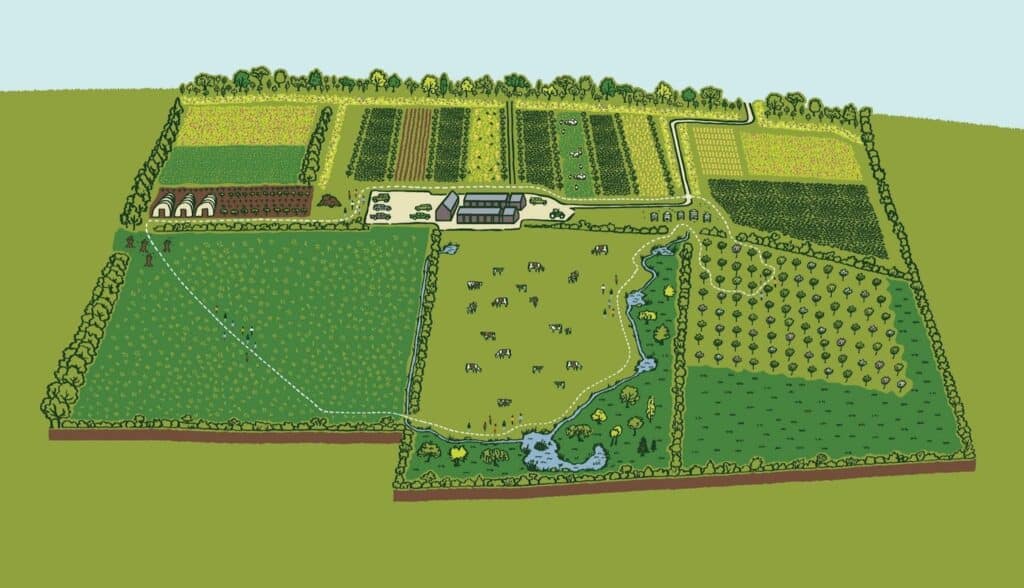About the Farm
FarmED has made its home at Honeydale Farm – a 107-acre demonstration farm in the Cotswolds – which seeks to act as a beacon of inspiration and learning for the agricultural community. The farm offers an impressive and diverse display of features; from mob-grazing, a micro-dairy, agroforestry, and wildflower margins, to a whole-farm Countryside Stewardship Scheme, fruit and veg growing, and natural flood management.

On founding FarmED, Ian explained how it aims to bring together thought leaders as well as new entrants to land management, creating a space to share learnings, opinions, and views whilst giving them a place to develop and grow. By offering a place to put into practice real-world solutions, the farm is a hub of education, and of hope.
Knowing the FarmED land
When Ian and his wife, Celene purchased the farm in 2013, Ian explained, they walked the land every day for a year to begin to learn and understand it. Mostly under the cover of darkness, at the end of a day’s work, their walks would take them all over, where they could hear, but rarely see, running water. They realised water was being pushed off the farm as quickly as possible, reducing wildlife and the land’s holding capacity considerably.
Situated in the hills of the Cotswolds, where natural springs swell from an artesian basin where clay meets limestone soil, the farm has a steady supply of water year-round, after which it flows down into the Evenlode valley, a tributary of the River Thames. Ian explained that the lack of ponds was something they were eager to fix early on: “We thought what do we do? We’re not landscape managers – we were new farmers, and didn’t know much about creating wetlands”. Rising to the challenge, with the help of a local expert and a digger, the water’s natural course was soon restored, re-routing the water pathway and building into the valley a series of small ponds with connecting channels.
“Just by making a different habitat we’ve attracted a lot of wildlife we weren’t seeing before”
The results, Ian explained, were immediate. Almost instantly, snipe appeared in the muddy banks, deer prints began to materialise, and before long, the blue streak of a kingfisher – a first for the farm. Asked about the ecological benefits of wetlands, Ian stressed they “have a huge impact”. All life on land, after all, requires water. Surface water on the farm is amazing for lots of species – invertebrates, and amphibians – providing this creates a whole new possibility for species. As time went on, the plant species increased too. Crucially, these were unsown; irises and reeds have arrived over the years, showing the capacity for nature recovery even in a small section of the farm. Without a doubt, “we know it’s a great thing from a biodiversity point of view”.

Fighting flooding
But the benefits don’t stop there. The natural flood management provided by wetlands serves human settlements as much as it does ecosystems. In 2008, the village below the farm flooded; 80 people had to move out of their waterlogged homes. Water came down off the hills rapidly after heavy rainfall, and the farmed landscape held no natural features to prevent this. Slowing the flow down was a key priority for the farm. The series of small dams (shown in the photo) are also called “attenuation bunds” – along with the meandering channels, these control the flow of water and ensure it is released at a much slower rate. Coupled with a “scrape” (a sort of shallow pond that holds flood and rainwater) that helps water drain into the subsoil, it greatly reduces the pressure created by heavy and unpredictable rainfall.
The newly planted trees also play a huge part – root systems create ideal pathways for water to soak into the subsoil – yet another barrier to prevent flooding like that of 2008. All of this also helps to reduce nutrient ‘run-off’, where valuable nutrients and topsoil are carried off the farm and lost to the river below.
So why do more farms need to consider wetlands and water management? Biodiversity benefits aside, in isolation, as Ian points out, “this won’t do much”. But “joined up across the valley on multiple farms – which is now happening – it just might”. Natural flood management is not about working in isolation but thinking about impact at the landscape scale. Coordinating initiatives like the one at FarmED through farming “clusters” means initiatives can be planned for maximum positive impact, and facilitators of these groups can secure funding through not only Environmental Land Management schemes (ELMs) but also private capital such as from water companies, Biodiversity Net Gain and nutrient neutrality schemes. FarmED sits within the North East Cotswold Farm Cluster, stretching from the hills of the Cotswolds to Blenheim Palace, one of many clusters benefiting from the collaborative functions of Land App.
“This could deliver so many benefits. It imagines people within the landscape, and in doing so, we make all sorts of positive connections”
A nature-friendly farm
But what are the impacts of wetland creation on food production? In Ian’s case, historically, animals in the field didn’t stray in these areas anyway, and it certainly wouldn’t suit crops. Over the expanse of the 100-acre farm, the wetland takes up 3 or 4 acres, an area Ian sees as “a small loss for a huge return”. As government schemes and policy race to account for “income foregone” and properly valuing “natural capital”, such schemes can expect to find more funding in the future. Ian highlights how the ponds and surrounding trees hold more carbon than anywhere else on the farm, along with the many other ecosystem benefits (“services”) provided.
FarmED, as a demonstration farm, is in many ways a leading light for the agricultural sector. Their natural flood management area is no exception. As the conversation in agriculture turns more and more to addressing the twin crises of climate and biodiversity loss, interventions that not only conserve water and carbon in the land but drastically improve biodiversity in the process, are surely welcome. Without a doubt, in the conversation for how to harmonise farming, nature, and human well-being, wetlands more than deserve a seat at the table.

